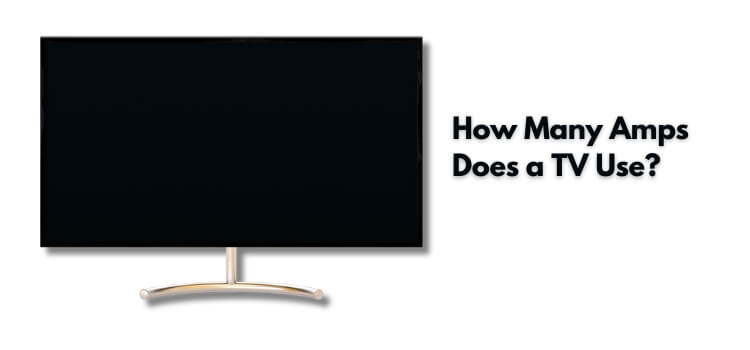As an Amazon Associate I earn from qualifying purchases.
Curious about the electrical consumption of your TV? Understanding how many amps does a TV use is essential for managing energy usage and ensuring your electrical system operates efficiently. Whether you’re concerned about electricity bills or simply want to know more about your devices, this guide will delve into the amp usage of TVs, shedding light on factors that influence consumption. In conclusion, you will know more about how your TV affects your energy usage. Let’s explore how many amps does a TV use and gain insights into managing your electrical usage effectively.
The Basics: Amps and Electricity
To understand how many amps a TV uses, we must first grasp the concept of amperage itself. Electric current measurement is done in amps, or amperage for short. It is expressed in amperes (A), which is the unit of measurement for the speed at which electricity moves across a circuit. In simple terms, amps indicate how much power an electrical device consumes over time. This consumption can be translated into energy costs on your monthly utility bill.
Lets Know How Many Amps Does a TV Use?
The number of amps a TV uses depends on various factors, such as the size and type of the TV, its settings, and usage habits. Generally speaking, larger TVs with higher resolution screens tend to use more power than smaller ones. For example, a 50-inch LED TV may consume around 100 watts or 0.83 amps while a 65-inch OLED TV could use up to 300 watts or 2.5 amps.
Calculating Amps for Your Specific TV
If you want a more precise calculation of how many amps your TV uses, you can follow these steps:
- Look for the power consumption information on your TV’s label or manual.
- Use the following formula to convert the power rating from watts to amps: amps = watts/volts.
- Determine the voltage of your household by checking your outlet or referring to your local utility provider’s information.
- To calculate the amount of amps your TV uses, divide its power rating in watts by its voltage.
Understanding Energy Efficiency Ratings
While knowing how many amps a TV uses is essential, it’s also crucial to understand energy efficiency ratings. These ratings show how much energy a TV uses in comparison to its size and features. The most widely used rating system is the Energy Star badge, which rates TV efficiency on a scale from 1 to 100. The TV is more energy-efficient and uses less power when its number is higher.
Determining TV Amperage
There are two primary methods to determine the amperage of your TV. The first involves checking the TV’s specifications, and the other is a simple calculation using wattage and voltage.
Method 1: Checking the TV’s Specifications
Most electronic devices, ranging from your everyday smartphone to larger household appliances, are accompanied by a label or an in-depth user manual that meticulously provides the amperage rating. This crucial piece of information, indicative of the device’s electrical consumption, is typically located near the power input area or is meticulously detailed within the technical data section of the manual. This ensures that users can easily find and understand the electrical requirements of their devices, promoting safe and efficient use.
Method 2: Calculating Amperage Using Wattage and Voltage
If you can’t find the amperage rating, you can calculate it using the wattage. Watts to amps can be easily calculated using this formula:
Amps = Watts ÷ Volts.
For example, if you have a 500-watt TV running at 120 volts:
500 ÷ 120 = 4.17 amps
Average Amps for Different Types of TVs
The average amperage of a TV can vary greatly depending on the type, model, and size, which is a crucial factor for those looking to reduce their energy consumption or accommodate their home’s electrical capacity. Fans of LED, LCD, and Plasma TVs will find the following details particularly illuminating and helpful in making an informed decision.
- LED TVs: Among the various types of televisions, LED TVs stand out as the most energy-efficient. The main reason for this is that they use light-emitting diodes, which use less power to provide sharp and colorful images. On average, LED TVs draw between 1.4 to 2.8 amps. Environmentally aware consumers appreciate them because of their efficiency, which does not degrade their performance.
- LCD TVs: LCD TVs, which utilize liquid crystal displays to project images, use a bit more power than their LED counterparts. The average amperage for LCD TVs ranges from 1.5 to 3.0 amps. While they consume slightly more energy, they remain a popular choice due to their balance between cost, performance, and power efficiency.
- Plasma TVs: Plasma TVs offer excellent picture quality, with deep blacks and high contrast ratios that make them ideal for cinephiles and those who prioritize image quality above all else. Nevertheless, increased power consumption is a price for this better quality. Plasma TVs are at the top end of the power consumption spectrum, with an average amperage of 3.5 to 4.5 amps. They nonetheless have a devoted fan base that appreciates their unique visual advantages while using more energy.
Understanding the amperage and energy consumption of these TV types is essential for anyone looking to purchase a new television. By considering these factors, consumers can make choices that align with their energy efficiency goals, budget constraints, and viewing preferences, ensuring a satisfying entertainment experience.
Tips for Reducing TV’s Amp Usage
If you’re on a mission to lower your TV’s amp usage and, as a result, save on energy costs, there are several practical steps you can take to achieve this. Here are some detailed tips to consider:
- Adjust the brightness and contrast settings: TVs often come with factory settings that are brighter than necessary for most homes. Reducing these settings not only decreases your TV’s power consumption but can also enhance your viewing experience by making it easier on the eyes, especially in dimly lit rooms.
- Enable energy-saving mode: Almost all modern smart TVs are equipped with an energy-saving or eco mode. This feature intelligently adjusts the screen’s brightness in response to the ambient light present in the room, minimizing energy usage without sacrificing picture quality. You can save a lot of money on your electricity bills over time by using this option.
- Unplug when not in use: Few people are aware that even when a TV is switched off, a lot of them still use a tiny bit of electricity. This standby power usage, while minimal for a single device, can add up across all the electronics in your home. To completely eliminate this energy drain, it’s a good habit to unplug your TV whenever it’s not in use. To make things easier, think about utilizing a power strip with a switch so you can turn off several devices at once.
You may help the environment and your pocketbook by putting these tips into practice to cut down on the energy your TV uses.
Conclusion
As we conclude our discussion on how many amps a TV uses, it’s important to understand that the amp usage of a TV can vary based on factors like size, model, and usage habits. Generally, most modern TVs consume around 1 to 2 amps per hour. To obtain a precise approximation, it’s advisable to examine the precise specifications of your television. By being aware of your TV’s amp usage, you can better manage your energy consumption and ensure your electrical system is operating efficiently.
Frequently Asked Questions
Q1: how many amps does a tv use on standby?
Answer: Most modern televisions are designed to be energy efficient, particularly in standby mode where they consume minimal power. On average, a TV in standby mode uses about 1 watt or less. This low power consumption translates to approximately 0.01 amps per hour, which is a testament to the advancements in energy-saving technology in consumer electronics. This means that even when your TV is not actively being used, it’s designed to ensure that its impact on your electricity bill and the environment is as minimal as possible.
Q2: Can I save energy by turning off my TV completely instead of just putting it on standby?
Answer: Yes, turning off your TV completely will save more energy compared to leaving it in standby mode. The best approach to stop the TV from using standby power is to unplug it when not in use.
Q3: Do all types of TVs have the same amp usage?
Answer: No, different types of TVs (such as LED, LCD, and Plasma) have varying levels of power consumption. Generally, LED TVs are the most energy-efficient while Plasma TVs consume the most amount of power. For a precise estimate, it’s crucial to review your TV’s exact characteristics.
Q4: How can I reduce my TV's amp usage?
Answer: By adjusting brightness and contrast settings, enabling energy-saving mode, and unplugging the TV when not in use, you can effectively lower your TV’s energy consumption. It’s also helpful to invest in a more energy-efficient TV model, such as an LED TV. Overall, being mindful of your usage habits and making small changes can have a significant impact on reducing amp usage and saving energy.
Q5: Is it worth investing in a more energy-efficient TV?
Answer: Yes, you can lower your carbon footprint and ultimately save money on power costs by making the investment in a more energy-efficient TV. It’s a financially and environmentally responsible decision.
Disclaimer: This post contains information that is solely intended for educational purposes; it is not intended to be used as professional advice. We strongly recommend consulting your TV’s specific specifications and the user manual to obtain accurate and detailed information regarding its power consumption and electrical ratings. It’s important to rely on these documents to ensure the correct and safe use of your television.
Personal Experience: I discovered that by making a small but effective adjustment to the brightness and contrast settings on my television, I was able to create a much more comfortable viewing experience. Not only did this simple tweak make the screen easier on my eyes, especially during long movie marathons, but it also led to a noticeable reduction in my electricity bill. This minor change, which took just a few moments to implement, proved to be both economically and environmentally beneficial, allowing me to enjoy my favorite shows and movies without the worry of excessive energy costs.
Why Trust Us?
At our core, we are dedicated to providing not just content, but accurate and actionable insights. Through comprehensive research and leveraging our deep expertise in the field, we’re here to ensure that the information you receive, especially regarding TV power usage, is not only reliable but also grounded in real-world applications. Trust us to be your go-to source for all matters related to understanding the intricacies of how your television consumes power, enabling you to make informed decisions.
As an Amazon Associate I earn from qualifying purchases.

